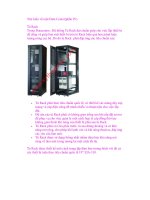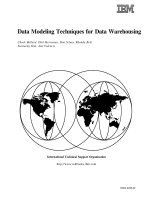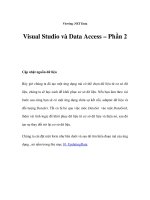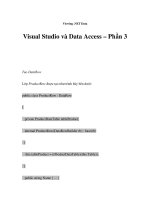Data Modeling Techniques for Data Warehousing phần 2 docx
Bạn đang xem bản rút gọn của tài liệu. Xem và tải ngay bản đầy đủ của tài liệu tại đây (140.5 KB, 21 trang )
accumulating and consolidating data from different sources, and by keeping this
historical data in the warehouse, new information about the business,
competitors, customers, suppliers, the behavior of the organization′s business
processes, and so forth, can be unveiled. The value of a data warehouse is no
longer in being able to do ad hoc query and reporting. The real value is realized
when someone gets to work with the data in the warehouse and discovers things
that make a difference for the organization, whatever the objective of the
analytical work may be. To achieve such interesting results, simply
reengineering the source data models will not do.
Chapter 2. Data Warehousing 7
8 Data Modeling Techniques for Data Warehousing
Chapter 3. Data Analysis Techniques
A data warehouse is built to provide an easy to access source of high quality
data. It is a means to an end, not the end itself. That end is typically the need
to perform analysis and decision making through the use of that source of data.
There are several techniques for data analysis that are in common use today.
They are query and reporting, multidimensional analysis, and data mining (see
Figure 1). They are used to formulate and
display
query results, to
analyze
data
content by viewing it from different perspectives, and to
discover
patterns and
clustering attributes in the data that will provide further insight into the data
content.
Figure 1. Data Analysis. Several methods of data analysis are in common use.
The techniques of data analysis can impact the type of data model selected and
its content. For example, if the intent is simply to provide query and reporting
capability, a data model that structures the data in more of a normalized fashion
would probably provide the fastest and easiest access to the data. Query and
reporting capability primarily consists of selecting associated data elements,
perhaps summarizing them and grouping them by some category, and
presenting the results. Executing this type of capability typically might lead to
the use of more direct table scans. For this type of capability, perhaps an ER
model with a normalized and/or denormalized data structure would be most
appropriate.
If the objective is to perform multidimensional data analysis, a dimensional data
model would be more appropriate. This type of analysis requires that the data
model support a structure that enables fast and easy access to the data on the
basis of any of numerous combinations of analysis dimensions. For example,
you may want to know how many of a specific product were sold on a specific
day, in a specific store, in a specific price range. Then for further analysis you
may want to know how many stores sold a specific product, in a specific price
range, on a specific day. These two questions require similar information, but
one viewed from a product perspective and the other viewed from a store
perspective.
Multidimensional analysis requires a data model that will enable the data to
easily and quickly be viewed from many possible perspectives, or dimensions.
Copyright IBM Corp. 1998 9
Since a number of dimensions are being used, the model must provide a way for
fast access to the data. If a highly normalized data structure were used, many
joins would be required between the tables holding the different dimension data,
and they could significantly impact performance. In this case, a dimensional
data model would be most appropriate.
An understanding of the data and its use will impact the choice of a data model.
It also seems clear that, in most implementations, multiple types of data models
might be used to best satisfy the varying requirements of the data warehouse.
3.1 Query and Reporting
Query and reporting analysis is the process of posing a question to be
answered, retrieving relevant data from the data warehouse, transforming it into
the appropriate context, and displaying it in a readable format. It is driven by
analysts who must pose those questions to receive an answer. You will find that
this is quite different, for example, from data mining, which is data driven. Refer
to Figure 4 on page 13.
Traditionally, queries have dealt with two dimensions, or two factors, at a time.
For example, one might ask, ″How much of that product has been sold this
week?″ Subsequent queries would then be posed to perhaps determine how
much of the product was sold by a particular store. Figure 2 depicts the process
flow in query and reporting. Query definition is the process of taking a business
question or hypothesis and translating it into a query format that can be used by
a particular decision support tool. When the query is executed, the tool
generates the appropriate language commands to access and retrieve the
requested data, which is returned in what is typically called an
answer set
. The
data analyst then performs the required calculations and manipulations on the
answer set to achieve the desired results. Those results are then formatted to fit
into a display or report template that has been selected for ease of
understanding by the end user. This template could consist of combinations of
text, graphic images, video, and audio. Finally, the report is delivered to the end
user on the desired output medium, which could be printed on paper, visualized
on a computer display device, or presented audibly.
Figure 2. Query and Reporting. The process of query and reporting starts with query definition and ends with
report delivery.
10 Data Modeling Techniques for Data Warehousing
End users are primarily interested in processing numeric values, which they use
to analyze the behavior of business processes, such as sales revenue and
shipment quantities. They may also calculate, or investigate, quality measures
such as customer satisfaction rates, delays in the business processes, and late
or wrong shipments. They might also analyze the effects of business
transactions or events, analyze trends, or extrapolate their predictions for the
future. Often the data displayed will cause the user to formulate another query
to clarify the answer set or gather more detailed information. This process
continues until the desired results are reached.
3.2 Multidimensional Analysis
Multidimensional analysis has become a popular way to extend the capabilities
of query and reporting. That is, rather than submitting multiple queries, data is
structured to enable fast and easy access to answers to the questions that are
typically asked. For example, the data would be structured to include answers to
the question, ″How much of each of our products was sold on a particular day,
by a particular sales person, in a particular store?″ Each separate part of that
query is called a
dimension
. By precalculating answers to each subquery within
the larger context, many answers can be readily available because the results
are not recalculated with each query; they are simply accessed and displayed.
For example, by having the results to the above query, one would automatically
have the answer to any of the subqueries. That is, we would already know the
answer to the subquery, ″How much of a particular product was sold by a
particular salesperson?″ Having the data categorized by these different factors,
or dimensions, makes it easier to understand, particularly by business-oriented
users of the data. Dimensions can have individual entities or a hierarchy of
entities, such as region, store, and department.
Multidimensional analysis enables users to look at a large number of
interdependent factors involved in a business problem and to view the data in
complex relationships. End users are interested in exploring the data at different
levels of detail, which is determined dynamically. The complex relationships can
be analyzed through an iterative process that includes drilling down to lower
levels of detail or rolling up to higher levels of summarization and aggregation.
Figure 3 on page 12 demonstrates that the user can start by viewing the total
sales for the organization and drill down to view the sales by continent, region,
country, and finally by customer. Or, the user could start at customer and roll up
through the different levels to finally reach total sales. Pivoting in the data can
also be used. This is a data analysis operation whereby the user takes a
different viewpoint than is typical on the results of the analysis, changing the
way the dimensions are arranged in the result. Like query and reporting,
multidimensional analysis continues until no more drilling down or rolling up is
performed.
Chapter 3. Data Analysis Techniques 11
Figure 3. Drill-Down and Roll-Up Analysis. End users can perform drill down or roll up when using
multidimensional analysis.
3.3 Data Mining
Data mining is a relatively new data analysis technique. It is very different from
query and reporting and multidimensional analysis in that is uses what is called
a
discovery technique
. That is, you do not ask a particular question of the data
but rather use specific algorithms that analyze the data and report what they
have discovered. Unlike query and reporting and multidimensional analysis
where the user has to create and execute queries based on hypotheses, data
mining searches for answers to questions that may have not been previously
asked. This discovery could take the form of finding significance in relationships
between certain data elements, a clustering together of specific data elements,
or other patterns in the usage of specific sets of data elements. After finding
these patterns, the algorithms can infer rules. These rules can then be used to
generate a model that can predict a desired behavior, identify relationships
among the data, discover patterns, and group clusters of records with similar
attributes.
Data mining is most typically used for statistical data analysis and knowledge
discovery. Statistical data analysis detects unusual patterns in data and applies
statistical and mathematical modeling techniques to explain the patterns. The
models are then used to forecast and predict. Types of statistical data analysis
techniques include linear and nonlinear analysis, regression analysis,
multivariant analysis, and time series analysis. Knowledge discovery extracts
implicit, previously unknown information from the data. This often results in
uncovering unknown business facts.
Data mining is data driven (see Figure 4 on page 13). There is a high level of
complexity in stored data and data interrelations in the data warehouse that are
difficult to discover without data mining. Data mining offers new insights into the
business that may not be discovered with query and reporting or
multidimensional analysis. Data mining can help discover new insights about
the business by giving us answers to questions we might never have thought to
ask.
12 Data Modeling Techniques for Data Warehousing
Figure 4. Data Mining. Data Mining focuses on analyzing the data content rather than simply responding to
questions.
3.4 Importance to Modeling
The type of analysis that will be done with the data warehouse can determine
the type of model and the model′s contents. Because query and reporting and
multidimensional analysis require summarization and explicit metadata, it is
important that the model contain these elements. Also, multidimensional
analysis usually entails drilling down and rolling up, so these characteristics
need to be in the model as well. A clean and clear data warehouse model is a
requirement, else the end users′ tasks will become too complex, and end users
will stop trusting the contents of the data warehouse and the information drawn
from it because of highly inconsistent results.
Data mining, however, usually works best with the lowest level of detail
available. Thus, if the data warehouse is used for data mining, a low level of
detail data should be included in the model.
Chapter 3. Data Analysis Techniques 13
14 Data Modeling Techniques for Data Warehousing
Chapter 4. Data Warehousing Architecture and Implementation
Choices
In this chapter we discuss the architecture and implementation choices available
for data warehousing. During the discussions we may use the term
data mart
.
Data marts, simply defined, are smaller data warehouses that can function
independently or can be interconnected to form a global integrated data
warehouse. However, in this book, unless noted otherwise, use of the term
data
warehouse
also implies data mart.
Although it is not always the case, choosing an architecture should be done prior
to beginning implementation. The architecture can be determined, or modified,
after implementation begins. However, a longer delay typically means an
increased volume of rework. And, everyone knows that it is more time
consuming and difficult to do rework after the fact than to do it right, or very
close to right, the first time. The architecture choice selected is a management
decision that will be based on such factors as the current infrastructure,
business environment, desired management and control structure, commitment
to and scope of the implementation effort, capability of the technical environment
the organization employs, and resources available.
The implementation approach selected is also a management decision, and one
that can have a dramatic impact on the success of a data warehousing project.
The variables affected by that choice are time to completion,
return-on-investment, speed of benefit realization, user satisfaction, potential
implementation rework, resource requirements needed at any point-in-time, and
the data warehouse architecture selected.
4.1 Architecture Choices
Selection of an architecture will determine, or be determined by, where the data
warehouses and/or data marts themselves will reside and where the control
resides. For example, the data can reside in a central location that is managed
centrally. Or, the data can reside in distributed local and/or remote locations
that are either managed centrally or independently.
The architecture choices we consider in this book are global, independent,
interconnected, or some combination of all three. The implementation choices to
be considered are top down, bottom up, or a combination of both. It should be
understood that the architecture choices and the implementation choices can
also be used in combinations. For example, a data warehouse architecture
could be physically distributed, managed centrally, and implemented from the
bottom up starting with data marts that service a particular workgroup,
department, or line of business.
4.1.1 Global Warehouse Architecture
A global data warehouse is considered one that will support all, or a large part,
of the corporation that has the requirement for a more fully integrated data
warehouse with a high degree of data access and usage across departments or
lines-of-business. That is, it is designed and constructed based on the needs of
the enterprise as a whole. It could be considered to be a common repository for
Copyright IBM Corp. 1998 15
decision support data that is available across the entire organization, or a large
subset thereof.
A common misconception is that a global data warehouse is centralized. The
term
global
is used here to reflect the scope of data access and usage, not the
physical structure. The global data warehouse can be physically centralized or
physically distributed throughout the organization. A physically centralized
global warehouse is to be used by the entire organization that resides in a
single location and is managed by the Information Systems (IS) department. A
distributed global warehouse is also to be used by the entire organization, but it
distributes the data across multiple physical locations within the organization
and is managed by the IS department.
When we say that the IS department manages the data warehouse, we do not
necessarily mean that it
controls
the data warehouse. For example, the
distributed locations could be controlled by a particular department or line of
business. That is, they decide what data goes into the data warehouse, when it
is updated, which other departments or lines of business can access it, which
individuals in those departments can access it, and so forth. However, to
manage the implementation of these choices requires support in a more global
context, and that support would typically be provided by IS. For example, IS
would typically manage network connections. Figure 5 shows the two ways that
a global warehouse can be implemented. In the top part of the figure, you see
that the data warehouse is distributed across three physical locations. In the
bottom part of the figure, the data warehouse resides in a single, centralized
location.
Figure 5. Global Warehouse Architecture. The two primary architecture approaches.
Data for the data warehouse is typically extracted from operational systems and
possibly from data sources external to the organization with batch processes
during off-peak operational hours. It is then filtered to eliminate any unwanted
data items and transformed to meet the data quality and usability requirements.
It is then loaded into the appropriate data warehouse databases for access by
end users.
16 Data Modeling Techniques for Data Warehousing
A global warehouse architecture enables end users to have more of an
enterprisewide or corporatewide view of the data. It should be certain that this
is a requirement, however, because this type of environment can be very time
consuming and costly to implement.
4.1.2 Independent Data Mart Architecture
An independent data mart architecture implies stand-alone data marts that are
controlled by a particular workgroup, department, or line of business and are
built solely to meet their needs. There may, in fact, not even be any connectivity
with data marts in other workgroups, departments, or lines of business. For
example, data for these data marts may be generated internally. The data may
be extracted from operational systems but would then require the support of IS.
IS would not control the implementation but would simply help manage the
environment. Data could also be extracted from sources of data external to the
organization. In this case IS could be involved unless the appropriate skills were
available within the workgroup, department, or line of business. The top part of
Figure 6 depicts the independent data mart structure. Although the figure
depicts the data coming from operational or external data sources, it could also
come from a global data warehouse if one exists.
The independent data mart architecture requires some technical skills to
implement, but the resources and personnel could be owned and managed by
the workgroup, department, or line of business. These types of implementation
typically have minimal impact on IS resources and can result in a very fast
implementation. However, the minimal integration and lack of a more global
view of the data can be a constraint. That is, the data in any particular data
mart will be accessible only to those in the workgroup, department, or line of
business that owns the data mart. Be sure that this is a known and accepted
situation.
Figure 6. Data Mart Architectures. They can be independent or interconnected.
Chapter 4. Data Warehousing Architecture and Implementation Choices 17
4.1.3 Interconnected Data Mart Architecture
An interconnected data mart architecture is basically a distributed
implementation. Although separate data marts are implemented in a particular
workgroup, department, or line of business, they can be integrated, or
interconnected, to provide a more enterprisewide or corporatewide view of the
data. In fact, at the highest level of integration, they can become the global data
warehouse. Therefore, end users in one department can access and use the
data on a data mart in another department. This architecture is depicted in the
bottom of Figure 6 on page 17. Although the figure depicts the data coming
from operational or external data sources, it could also come from a global data
warehouse if one exists.
This architecture brings with it many other functions and capabilities that can be
selected. Be aware, however, that these additional choices can bring with them
additional integration requirements and complexity as compared to the
independent data mart architecture. For example, you will now need to consider
who controls and manages the environment. You will need to consider the need
for another tier in the architecture to contain, for example, data common to
multiple data marts. Or, you may need to elect a data sharing schema across
the data marts. Either of these choices adds a degree of complexity to the
architecture. But, on the positive side, there can be significant benefit to the
more global view of the data.
Interconnected data marts can be independently controlled by a workgroup,
department, or line of business. They decide what source data to load into the
data mart, when to update it, who can access it, and where it resides. They may
also elect to provide the tools and skills necessary to implement the data mart
themselves. In this case, minimal resources would be required from IS. IS
could, for example, provide help in cross-department security, backup and
recovery, and the network connectivity aspects of the implementation. In
contrast, interconnected data marts could be controlled and managed by IS.
Each workgroup, department, or line of business would have its own data mart,
but the tools, skills, and resources necessary to implement the data marts would
be provided by IS.
4.2 Implementation Choices
Several approaches can be used to implement the architectures discussed in
4.1, “Architecture Choices” on page 15. The approaches to be discussed in this
book are top down, bottom up, or a combination of both. These implementation
choices offer flexibility in determining the criteria that are important in any
particular implementation.
The choice of an implementation approach is influenced by such factors as the
current IS infrastructure, resources available, the architecture selected, scope of
the implementation, the need for more global data access across the
organization, return-on-investment requirements, and speed of implementation.
18 Data Modeling Techniques for Data Warehousing
4.2.1 Top Down Implementation
A top down implementation requires more planning and design work to be
completed at the beginning of the project. This brings with it the need to involve
people from each of the workgroups, departments, or lines of business that will
be participating in the data warehouse implementation. Decisions concerning
data sources to be used, security, data structure, data quality, data standards,
and an overall data model will typically need to be completed before actual
implementation begins. The top down implementation can also imply more of a
need for an enterprisewide or corporatewide data warehouse with a higher
degree of cross workgroup, department, or line of business access to the data.
This approach is depicted in Figure 7. As shown, with this approach, it is more
typical to structure a global data warehouse. If data marts are included in the
configuration, they are typically built afterward. And, they are more typically
populated from the global data warehouse rather than directly from the
operational or external data sources.
Figure 7. Top Down Implementation. Creating a corporate infrastructure first.
A top down implementation can result in more consistent data definitions and
the enforcement of business rules across the organization, from the beginning.
However, the cost of the initial planning and design can be significant. It is a
time-consuming process and can delay actual implementation, benefits, and
return-on-investment. For example, it is difficult and time consuming to
determine, and get agreement on, the data definitions and business rules among
all the different workgroups, departments, and lines of business participating.
Developing a global data model is also a lengthy task. In many organizations,
management is becoming less and less willing to accept these delays.
The top down implementation approach can work well when there is a good
centralized IS organization that is responsible for all hardware and other
computer resources. In many organizations, the workgroups, departments, or
lines of business may not have the resources to implement their own data marts.
Top down implementation will also be difficult to implement in organizations
where the workgroup, department, or line of business has its own IS resources.
They are typically unwilling to wait for a more global infrastructure to be put in
place.
Chapter 4. Data Warehousing Architecture and Implementation Choices 19
4.2.2 Bottom Up Implementation
A bottom up implementation involves the planning and designing of data marts
without waiting for a more global infrastructure to be put in place. This does not
mean that a more global infrastructure will not be developed; it will be built
incrementally as initial data mart implementations expand. This approach is
more widely accepted today than the top down approach because immediate
results from the data marts can be realized and used as justification for
expanding to a more global implementation. Figure 8 depicts the bottom up
approach. In contrast to the top down approach, data marts can be built before,
or in parallel with, a global data warehouse. And as the figure shows, data
marts can be populated either from a global data warehouse or directly from the
operational or external data sources.
Figure 8. Bottom Up Implementation. Starts with a data mart and expands over time.
The bottom up implementation approach has become the choice of many
organizations, especially business management, because of the faster payback.
It enables faster results because data marts have a less complex design than a
global data warehouse. In addition, the initial implementation is usually less
expensive in terms of hardware and other resources than deploying the global
data warehouse.
Along with the positive aspects of the bottom up approach are some
considerations. For example, as more data marts are created, data redundancy
and inconsistency between the data marts can occur. With careful planning,
monitoring, and design guidelines, this can be minimized. Multiple data marts
may bring with them an increased load on operational systems because more
data extract operations are required. Integration of the data marts into a more
global environment, if that is the desire, can be difficult unless some degree of
planning has been done. Some rework may also be required as the
implementation grows and new issues are uncovered that force a change to the
existing areas of the implementation. These are all considerations to be
carefully understood before selecting the bottom up approach.
20 Data Modeling Techniques for Data Warehousing
4.2.3 A Combined Approach
As we have seen, there are both positive and negative considerations when
implementing with the top down or the bottom up approach. In many cases the
best approach may be a combination of the two. This can be a difficult
balancing act, but with a good project manager it can be done. One of the keys
to this approach is to determine the degree of planning and design that is
required for the global approach to support integration as the data marts are
being built with the bottom up approach. Develop a base level infrastructure
definition for the global data warehouse, being careful to stay, initially, at a
business level. For example, as a first step simply identify the lines of business
that will be participating. A high level view of the business processes and data
areas of interest to them will provide the elements for a plan for implementation
of the data marts.
As data marts are implemented, develop a plan for how to handle the data
elements that are needed by multiple data marts. This could be the start of a
more global data warehouse structure or simply a common data store
accessible by all the data marts. It some cases it may be appropriate to
duplicate the data across multiple data marts. This is a trade-off decision
between storage space, ease of access, and the impact of data redundancy
along with the requirement to keep the data in the multiple data marts at the
same level of consistency.
There are many issues to be resolved in any data warehousing implementation.
Using the combined approach can enable resolution of these issues as they are
encountered, and in the smaller scope of a data mart rather than a global data
warehouse. Careful monitoring of the implementation processes and
management of the issues could result in gaining the best benefits of both
implementation techniques.
Chapter 4. Data Warehousing Architecture and Implementation Choices 21
22 Data Modeling Techniques for Data Warehousing
Chapter 5. Architecting the Data
A data warehouse is, by definition, a subject-oriented, integrated, time-variant
collection of
data
to enable decision making across a disparate group of users.
One of the most basic concepts of data warehousing is to clean, filter, transform,
summarize, and aggregate the data, and then put it in a structure for easy
access and analysis by those users. But, that structure must first be defined and
that is the task of the data warehouse model. In modeling a data warehouse, we
begin by architecting the data. By architecting the data, we structure and locate
it according to its characteristics.
In this chapter, we review the types of data used in data warehousing and
provide some basic hints and tips for architecting that data. We then discuss
approaches to developing a data warehouse data model along with some of the
considerations.
Having an enterprise data model (EDM) available would be very helpful, but not
required, in developing the data warehouse data model. For example, from the
EDM you can derive the general scope and understanding of the business
requirements. The EDM would also let you relate the data elements and the
physical design to a specific area of interest.
Data granularity is one of the most important criteria in architecting the data. On
one hand, having data of a high granularity can support any query. However,
having a large volume of data that must be manipulated and managed could be
an issue as it would impact response times. On the other hand, having data of a
low granularity would support only specific queries. But, with the reduced
volume of data, you would realize significant improvements in performance.
The size of a data warehouse varies, but they are typically quite large. This is
especially true as you consider the impact of storing volumes of historical data.
To deal with this issue you have to consider data partitioning in the data
architecture. We consider both logical and physical partitioning to better
understand and maintain the data. In logical partitioning of data, you should
consider the concept of
subject areas
. This concept is typically used in most
information engineering (IE) methodologies. We discuss subject areas and their
different definitions in more detail later in this chapter.
5.1 Structuring the Data
In structuring the data, for data warehousing, we can distinguish three basic
types of data that can be used to satisfy the requirements of an organization:
•
Real-time data
•
Derived data
•
Reconciled data
In this section, we describe these three types of data according to usage, scope,
and currency. You can configure an appropriate data warehouse based on these
three data types, with consideration for the requirements of any particular
implementation effort. Depending on the nature of the operational systems, the
type of business, and the number of users that access the data warehouse, you
Copyright IBM Corp. 1998 23
can combine the three types of data to create the most appropriate architecture
for the data warehouse.
5.1.1 Real-Time Data
Real-time data represents the current status of the business. It is typically used
by operational applications to run the business and is constantly changing as
operational transactions are processed. Real-time data is at a detailed level,
meaning high granularity, and is usually accessed in read/write mode by the
operational transactions.
Not confined to operational systems, real-time data is extracted and distributed
to informational systems throughout the organization. For example, in the
banking industry, where real-time data is critical for operational management
and tactical decision making, an independent system, the so-called
deferred
or
delayed
system, delivers the data from the operational systems to the
informational systems (data warehouses) for data analysis and more strategic
decision making.
To use real-time data in a data warehouse, typically it first must be cleansed to
ensure appropriate data quality, perhaps summarized, and transformed into a
format more easily understood and manipulated by business analysts. This is
because the real-time data contains all the individual, transactional, and detailed
data values as well as other data valuable only to the operational systems that
must be filtered out. In addition, because it may come from multiple different
systems, real-time data may not be consistent in representation and meaning.
As an example, the units of measure, currency, and exchange rates may differ
among systems. These anomalies must be reconciled before loading into the
data warehouse.
5.1.2 Derived Data
Derived data is data that has been created perhaps by summarizing, averaging,
or aggregating the real-time data through some process. Derived data can be
either detailed or summarized, based on requirements. It can represent a view
of the business at a specific point in time or be a historical record of the
business over some period of time.
Derived data is traditionally used for data analysis and decision making. Data
analysts seldom need large volumes of detailed data; rather they need
summaries that are much easier for manipulation and use. Manipulating large
volumes of atomic data can also require tremendous processing resources.
Considering the requirements for improved query processing capability, an
efficient approach is to precalculate derived data elements and summarize the
detailed data to better meet user requirements. Efficiently processing large
volumes of data in an appropriate amount of time is one of the most important
issues to resolve.
5.1.3 Reconciled Data
Reconciled data is real-time data that has been cleansed, adjusted, or enhanced
to provide an integrated source of quality data that can be used by data analysts.
The basic requirement for data quality is consistency. In addition, we can create
and maintain historical data while reconciling the data. Thus, we can say
reconciled data is a special type of derived data.
24 Data Modeling Techniques for Data Warehousing
Reconciled data is seldom explicitly defined. It is usually a logical result of
derivation operations. Sometimes reconciled data is stored only as temporary
files that are required to transform operational data for consistency.
5.2 Enterprise Data Model
An EDM is a consistent definition of all of the data elements common to the
business, from a high-level business view to a generic logical data design. It
includes links to the physical data designs of individual applications. Through an
EDM, you can derive the general scope and understanding of the business
requirements.
5.2.1 Phased Enterprise Data Modeling
Many methodologies for enterprise data modeling have been published. Some
publications propose a three-tiered methodology such as conceptual, logical, and
physical data model. In IBM′s Worldwide Solution Design and Delivery Method
(WSDDM), five tiers are described for information engineering approaches:
•
ISP - Information System Planning
•
BAA - Business Area Analysis
•
BSD - Business System Design
•
BSI - Business System Implementation
•
BSM - Business System Maintenance
Despite the differences of the number of tiers, the common thread is that every
methodology focuses on the
phased
or layered approach. The phases include
the tasks for information planning, business analyzing, logical data modeling,
and physical data design as shown on Figure 9.
Figure 9. The Phased Enterprise Data Model (EDM)
The size of the phases in Figure 9 represents the amount of information to be
included in that phase of the model. That is, the pyramid shape implies that the
amount of information is minimal at the planning phase but increases
remarkably at the physical data design phase.
The
information planning
phase at the top of the pyramid provides the highly
consolidated view of the business. In that view, we can identify some number of
business concepts, usually in the range of 10 to 30. Those business concepts
Chapter 5. Architecting the Data 25
can be categorized as a
business entity
,
super entity
, or
subject area
in which an
organization is interested and about which it maintains data elements.
Examples of those are customer, product, organization, schedule, activity, and
policy. The purpose of this phase is to set up the
scope and architecture
of a
data warehouse and to provide a single, comprehensive point of view for the
other phases.
The
business analyzing
phase provides a means of further defining the contents
of the primary concepts and categorizing those contents according to various
business rules. This phase is described in business terms so that business
people who have no modeling training can understand it. The purpose of this
phase is to gather and arrange business requirements and define the business
terms specifically.
The
logical data modeling
phase is primarily enterprisewide in scope and
generic to all applications located below it in the pyramid. The logical data
model typically consists of several hundred entities. It is a complete model that
is in third normal form and contains the identification and definition of all
entities, relationships, and attributes. For further specific analysis, the entities of
the logical data model are sometimes partitioned into views by subject areas or
by applications. Some methodologies divide this phase into two phases:
•
Generic logical data model - the enterprise level
•
Logical application model - application level of data view
The
physical data design
applies physical constraints, such as space,
performance, and the physical distribution of data. The purpose of this phase is
to design for the actual physical implementation.
5.2.2 A Simple Enterprise Data Model
In general it is not possible, or practical, to assign resources to all of the
development phases concurrently when constructing an EDM. However, some of
the core components that are required for data warehouse modeling can be
extracted and grouped and used as a phased approach. In this book we call that
phased approach a
simple EDM
.
Figure 10 on page 27 shows an example of a simple EDM that consists of
subject areas and the relationships among them. We suggest drawing a simple
EDM diagram for each subject you select for your data warehouse model.
For a simple EDM, make a list of subject areas, typically less than 25. Then,
draw a
subject area model
of the organization by defining the business
relationships among the subject areas.
When you have completed the subject area model, you will need to define the
contents of each subject area. For example, when you define
customer
, you
cannot simply say that customer is the person in an organization that has a
business relationship with your organization. For example, you must make it
clear whether the
person
includes a prospect or ex-customer. When referring to
the
organization
, be clear as to whether it can be only a registered business,
and not simply a social or civic interest group.
If possible, draw an ER diagram for each subject area. Do not be too concerned
about the details, such as relationship name and cardinality. Just identify the
primary entities and the relationships among them.
26 Data Modeling Techniques for Data Warehousing
Figure 10. A Simple Enterprise Data Model
The objective of a simple EDM is to scope a specific area of interest and develop
a general understanding of it. It will be very helpful in the development of your
data warehouse model.
5.2.3 The Benefits of EDM
Compared to an application or departmental model, an EDM has these benefits:
•
Provides a single development base for applications and promotes the
integration of existing applications
•
Supports the sharing of data among different areas of the business
•
Provides a single set of consistent data definitions
The benefits of the EDM are being challenged today because a number of
organizations have attempted to create them and have been largely
unsuccessful. The following are some of the reasons for this lack of success:
•
The scope of EDM tends to cover the entire enterprise. Therefore, the size
of the project tended to be so big that it seldom delivered the proper results
in a reasonable period of time.
•
To deliver the value of EDM to the business, all areas of the organization
must be involved concurrently, which is an unrealistic expectation.
•
The people required in an EDM project must have both a broad
understanding of the business and a detailed knowledge of a specific
business area. It is difficult to find such people, but even if you can, it is
more difficult to get them assigned to the modeling task rather than
performing their standard business duties.
Chapter 5. Architecting the Data 27









